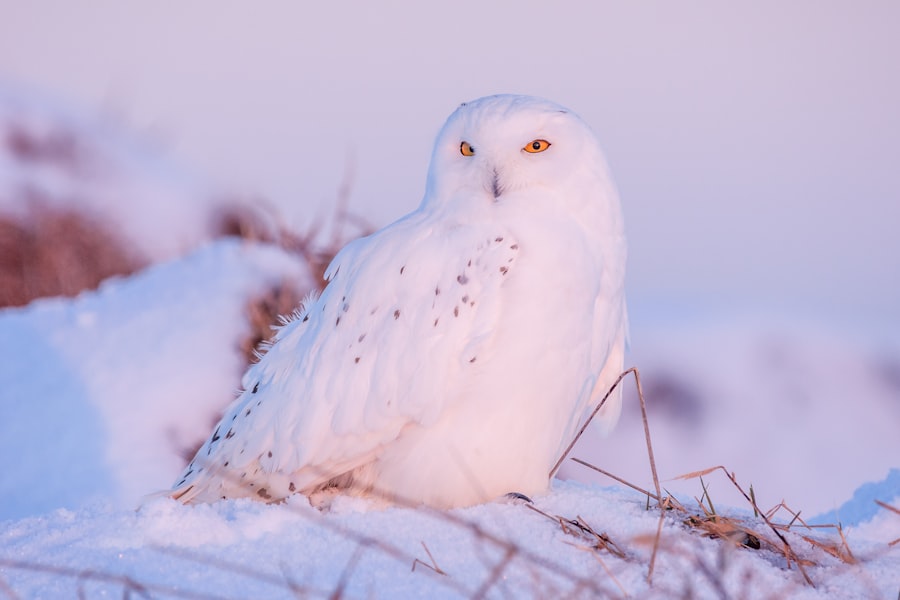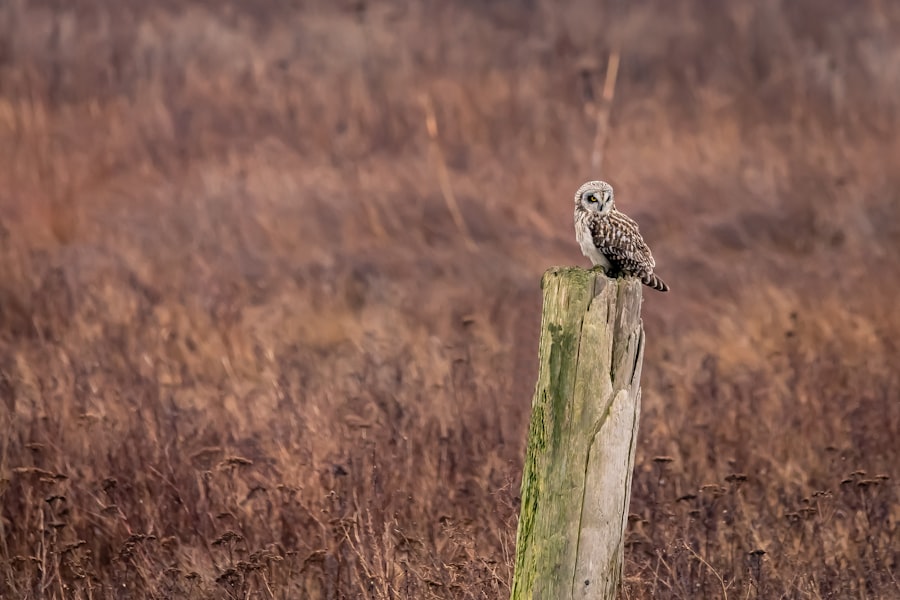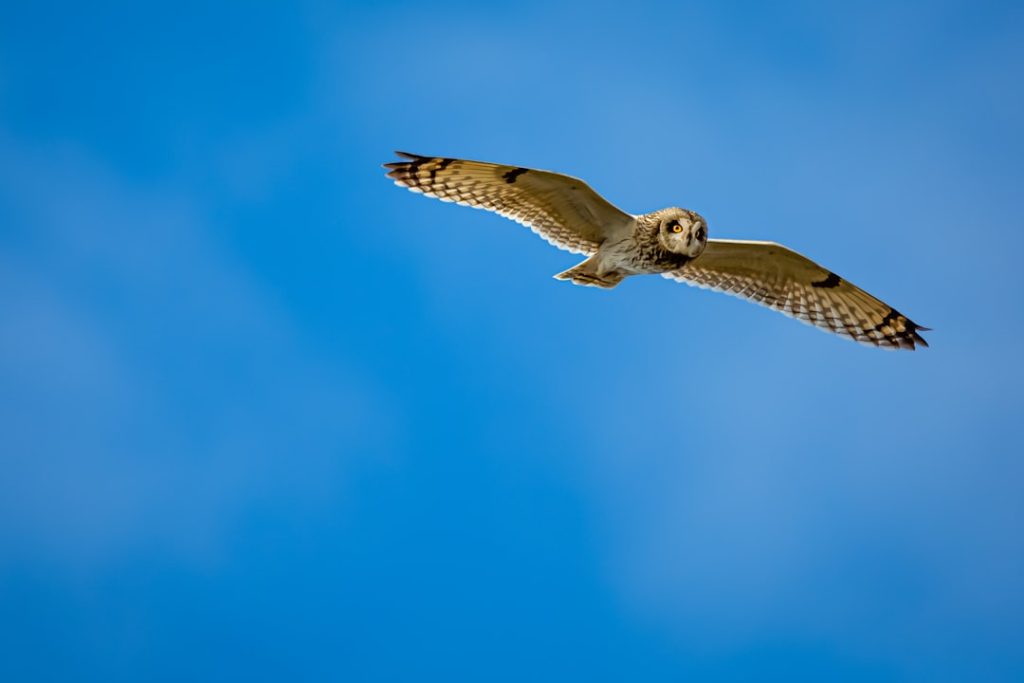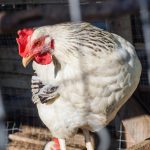Owls are nocturnal birds of prey known for their silent flight and keen hunting abilities. They pose a significant threat to small animals, including chickens and other poultry. Poultry owners should be able to identify signs of owl presence to protect their flock.
Common indicators include:
1. Owl pellets: Regurgitated indigestible parts of prey, such as bones and fur. 2.
Nocturnal hoots and calls. 3. Sudden disappearance of small animals in the area.
4. Owl feathers and droppings near the coop. 5.
Unusual behavior in the flock, such as increased agitation or fearfulness at night. Owls are stealthy predators that can be difficult to detect. Poultry owners should regularly inspect their property for signs of owl activity and remain alert to changes in their flock’s behavior.
Understanding the threat and identifying owl presence allows for proactive measures to protect poultry from potential attacks.
Table of Contents
- 1 Implementing Physical Barriers: Building Owl-proof Coops and Fencing
- 2 Utilizing Visual Deterrents: Scarecrows and Reflective Devices
- 3 Sound-based Repellents: Using Ultrasonic Devices and Noise-makers
- 4 Natural Predators: Introducing Guardian Animals to Protect Your Flock
- 5 Night-time Protection: Installing Motion-activated Lights and Alarms
- 6 Maintaining a Clean and Tidy Environment: Removing Attractants and Hiding Places for Owls
- 7 FAQs
- 7.1 What are some natural ways to keep owls away from your chickens?
- 7.2 What are some physical barriers that can be used to keep owls away from chickens?
- 7.3 Are there any specific plants or herbs that can help keep owls away from chickens?
- 7.4 What should I do if I spot an owl near my chicken coop?
- 7.5 Are there any legal considerations when it comes to keeping owls away from chickens?
Key Takeaways
- Owls can be identified by their distinct calls and pellet droppings, indicating their presence in the area.
- Building owl-proof coops and fencing can effectively prevent owls from accessing poultry and livestock.
- Scarecrows and reflective devices can be used to visually deter owls from approaching the property.
- Ultrasonic devices and noise-makers can be employed to repel owls with sound-based repellents.
- Introducing guardian animals, such as dogs or llamas, can help protect flocks from owl attacks.
Implementing Physical Barriers: Building Owl-proof Coops and Fencing
Physical Barriers: Owl-Proof Coops and Fencing
One effective way to safeguard poultry from owl attacks is by implementing physical barriers such as owl-proof coops and fencing. Owl-proof coops are designed to prevent owls from gaining access to the poultry by using sturdy materials and secure construction. These coops should have solid walls and roofs to prevent owls from reaching through or breaking in.
Securing Openings and Fencing
Additionally, it’s essential to ensure that all openings, such as doors and windows, are securely closed at night when owls are most active. Fencing can also be an effective physical barrier against owl attacks. By installing tall, sturdy fencing around the poultry area, poultry owners can prevent owls from swooping in and grabbing their prey. The fencing should be at least 6 feet tall and made of materials that are difficult for owls to perch on or climb over.
Additional Protective Measures
In addition to owl-proof coops and fencing, poultry owners can also consider using netting or wire mesh to further protect their flock from owl attacks. Netting can be installed over the top of the poultry area to prevent owls from swooping down and grabbing their prey. Similarly, wire mesh can be used to reinforce existing fencing or coop structures, making it more difficult for owls to gain access. Regular inspections of these physical barriers are crucial to identify any signs of wear or damage, as even small openings can provide an opportunity for owls to attack.
By building owl-proof coops and implementing sturdy fencing, poultry owners can create a secure environment for their flock and minimize the risk of owl attacks.
Utilizing Visual Deterrents: Scarecrows and Reflective Devices

Visual deterrents such as scarecrows and reflective devices can be effective in deterring owls from targeting poultry. Scarecrows are traditional deterrents that can be placed in the vicinity of the poultry area to create the illusion of a human presence. Owls are known to be cautious around unfamiliar objects, and the presence of a scarecrow may discourage them from approaching the area.
It’s important for poultry owners to regularly move and change the appearance of the scarecrow to maintain its effectiveness. Reflective devices such as shiny tape or CDs can also be used to deter owls by creating flashes of light that may startle or confuse them. By hanging these reflective devices around the poultry area, poultry owners can create a visual deterrent that may discourage owls from targeting their flock.
Another visual deterrent that can be effective in deterring owls is the use of predator decoys such as plastic owls or hawks. These decoys create the illusion of a larger predator in the area, which may discourage owls from approaching. It’s important for poultry owners to regularly move and reposition these decoys to maintain their effectiveness, as owls may become accustomed to their presence over time.
Additionally, motion-activated visual deterrents such as flashing lights or strobes can also be effective in deterring owls by creating sudden bursts of light that may startle them. By utilizing visual deterrents such as scarecrows, reflective devices, and predator decoys, poultry owners can create a hostile environment for owls and reduce the risk of attacks on their flock.
Sound-based Repellents: Using Ultrasonic Devices and Noise-makers
Sound-based repellents such as ultrasonic devices and noise-makers can be effective in deterring owls from targeting poultry. Ultrasonic devices emit high-frequency sound waves that are inaudible to humans but can be disruptive and uncomfortable for owls. By installing these devices around the poultry area, poultry owners can create a hostile environment that may discourage owls from approaching.
It’s important for poultry owners to regularly inspect and maintain these ultrasonic devices to ensure their effectiveness. Additionally, noise-makers such as air horns or whistles can also be used to deter owls by creating loud and sudden sounds that may startle them. By using these sound-based repellents, poultry owners can create a hostile environment for owls and reduce the risk of attacks on their flock.
Another sound-based repellent that can be effective in deterring owls is the use of recorded predator calls or distress signals. These recordings can create the illusion of a larger predator in the area or signal danger, which may discourage owls from approaching. It’s important for poultry owners to regularly change and vary these recordings to maintain their effectiveness, as owls may become accustomed to repetitive sounds over time.
Additionally, motion-activated sound-based repellents such as alarms or sirens can also be effective in deterring owls by creating sudden bursts of loud noise that may startle them. By utilizing sound-based repellents such as ultrasonic devices, noise-makers, and recorded calls, poultry owners can create a hostile environment for owls and reduce the risk of attacks on their flock.
Natural Predators: Introducing Guardian Animals to Protect Your Flock
Introducing guardian animals such as dogs or geese can be an effective way to protect poultry from owl attacks. Dogs are natural predators that can provide protection by patrolling the area and deterring potential threats such as owls. By introducing a well-trained dog to the poultry area, poultry owners can create a hostile environment for owls and reduce the risk of attacks on their flock.
Similarly, geese are known for their aggressive behavior towards potential threats, making them effective guardians for poultry. By introducing geese to the area, poultry owners can create a hostile environment that may discourage owls from approaching. In addition to dogs and geese, other guardian animals such as llamas or donkeys can also provide protection for poultry by deterring potential threats such as owls.
These animals are known for their territorial behavior and protective instincts, making them effective guardians for poultry. By introducing guardian animals to the area, poultry owners can create a hostile environment that may discourage owls from targeting their flock. It’s important for poultry owners to carefully introduce and train these guardian animals to ensure they are compatible with the flock and capable of providing effective protection.
By introducing guardian animals such as dogs, geese, llamas, or donkeys, poultry owners can create a secure environment for their flock and minimize the risk of owl attacks.
Night-time Protection: Installing Motion-activated Lights and Alarms

Effective Deterrents: Motion-Activated Lights
Installing motion-activated lights around the poultry area can provide effective protection against owl attacks during the night. These lights are designed to turn on when they detect movement in the area, creating sudden bursts of light that may startle or deter owls. By installing these lights, poultry owners can create a hostile environment for owls and reduce the risk of attacks on their flock.
Maintenance is Key
It’s essential for poultry owners to regularly inspect and maintain these lights to ensure their effectiveness. Additionally, installing alarms or sirens that are triggered by motion can also be effective in deterring owls from targeting poultry at night. These alarms create sudden bursts of loud noise that may startle or deter owls from approaching the area.
Creating a Secure Environment
By installing motion-activated lights and alarms around the poultry area, poultry owners can create a secure environment for their flock during the night and minimize the risk of owl attacks. Regular testing and maintenance of these systems are crucial to ensure they are functioning properly.
Maintaining a Clean and Tidy Environment: Removing Attractants and Hiding Places for Owls
Maintaining a clean and tidy environment around the poultry area is essential in minimizing attractants and hiding places for owls. Owls are attracted to areas with abundant prey such as rodents or insects, making it important for poultry owners to keep the area free of food sources that may attract owls. Additionally, it’s important to regularly remove any debris or clutter around the poultry area that may provide hiding places for owls.
By maintaining a clean and tidy environment, poultry owners can minimize attractants and hiding places for owls, reducing the risk of attacks on their flock. In addition to removing attractants and hiding places, it’s important for poultry owners to regularly inspect and maintain the surrounding vegetation around the poultry area. Overgrown bushes or trees can provide perches and hiding places for owls, making it important for poultry owners to trim back any vegetation that may provide cover for potential threats.
By maintaining a clear line of sight around the poultry area, poultry owners can reduce the risk of owl attacks on their flock. It’s also important for poultry owners to regularly inspect and repair any structures or buildings around the area that may provide roosting or nesting sites for owls. By maintaining a clean and tidy environment, poultry owners can minimize attractants and hiding places for owls, creating a secure environment for their flock.
In conclusion, protecting poultry from owl attacks requires a multi-faceted approach that includes understanding the threat, implementing physical barriers, utilizing visual deterrents, using sound-based repellents, introducing guardian animals, providing night-time protection, and maintaining a clean environment free of attractants and hiding places for owls. By being able to identify signs of owl presence and taking proactive measures such as building owl-proof coops and fencing, using scarecrows and reflective devices, installing ultrasonic devices and noise-makers, introducing guardian animals, installing motion-activated lights and alarms, and maintaining a clean environment, poultry owners can create a secure environment for their flock and minimize the risk of owl attacks. It’s important for poultry owners to regularly inspect and maintain these protective measures to ensure they remain effective in deterring potential threats such as owls.
If you’re looking for ways to keep owls away from your chickens, you may also be interested in learning about the ideal size for a chicken coop. This article discusses the importance of providing enough space for your chickens to live comfortably and safely. It also offers helpful tips on how to determine the right size for your coop based on the number of chickens you have. Understanding the proper coop size can contribute to the overall well-being and protection of your flock.
FAQs
What are some natural ways to keep owls away from your chickens?
Some natural ways to keep owls away from your chickens include using reflective surfaces, such as CDs or mirrors, to create a deterrent, installing motion-activated lights or sprinklers, and using scare tactics like loud noises or predator decoys.
What are some physical barriers that can be used to keep owls away from chickens?
Physical barriers that can be used to keep owls away from chickens include installing netting or wire mesh over the chicken coop, using a roof or cover to protect the chickens, and ensuring that the coop is secure and free from any openings that owls could enter through.
Are there any specific plants or herbs that can help keep owls away from chickens?
Some plants and herbs that are known to repel owls include lavender, marigolds, and mint. Planting these around the chicken coop can help deter owls from coming near the area.
What should I do if I spot an owl near my chicken coop?
If you spot an owl near your chicken coop, it’s important to take immediate action to protect your chickens. You can use scare tactics like loud noises or flashing lights to deter the owl, or you can physically escort the owl away from the area.
Are there any legal considerations when it comes to keeping owls away from chickens?
In some areas, owls are protected species, so it’s important to check local laws and regulations before taking any action to keep them away from your chickens. It may be necessary to obtain permits or seek professional assistance in dealing with owl-related issues.
Meet Walter, the feathered-friend fanatic of Florida! Nestled in the sunshine state, Walter struts through life with his feathered companions, clucking his way to happiness. With a coop that’s fancier than a five-star hotel, he’s the Don Juan of the chicken world. When he’s not teaching his hens to do the cha-cha, you’ll find him in a heated debate with his prized rooster, Sir Clucks-a-Lot. Walter’s poultry passion is no yolk; he’s the sunny-side-up guy you never knew you needed in your flock of friends!







